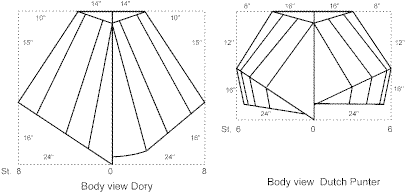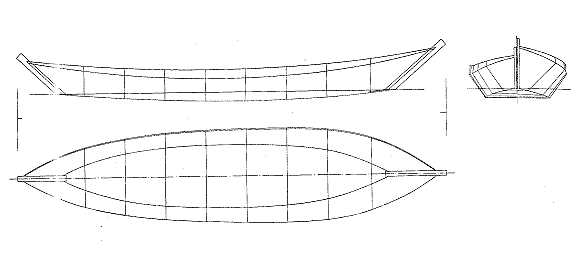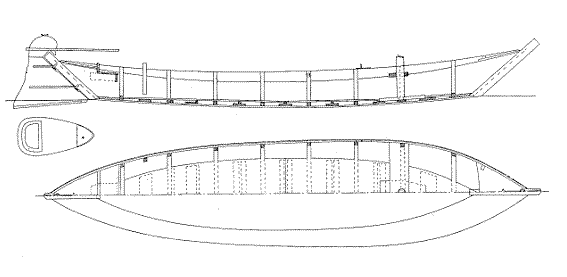| Short Wave
Before it was closed off in1932 and became Ysselmeer, the Zuiderzee
covered about one quarter of The Netherlands. It was an inland sea that
was very shallow at many places. It was open to the North Sea.
When the seasonal Northwester storms from this sea blew the water
into the Zuiderzee, it became a dangerous place to be caught on. The many
shallows caused what is called a short wave. It is an irregular wave
pattern: two or three regular waves are suddenly followed up by an often
very strong cross wave that can wrestle the helm out of the hand and break
the rudder. It becomes very difficult to stay on course. Usually, a few
Dutch barges stranded in that kind of weather with the danger of breaking
up.

Rescue Boats
The rescue boats that were used to save the Dutch bargemen, and
often their families that lived on board, were usually Staverse Jollen at
the northwest coast and Sea Punters in the southeast areas.
A Staverse Jol is a sturdy, round-bilged, small fishing boat with a
high bow and high tumbling-home sides. A narrow keel of about twelve (12)
inches ran from bow to stern. The sides are often made of 1"-actual, oak
planks.
The Sea Punter is a tumbled-home, hard-chined, flat-bottomed, small
fishing boat with leeboards developed from the double-ender.
The side panels have about the same flare angle as the dories, but
half the panelsí width. That makes for a wider bottom. A wide,
tumbled-home plank is attached on these relative narrow sides. It gives
the top edge a nearly horizontal look. Both types of boats, the jol and
the sea punter, where around 24" long and can be qualified as small boats.
Their hulls have a pronouncing codsí-head, mackerel-tail shape.
Punters
Punters come in two classes:
1.The farmersí punter. It is a dory-type double-ender without a
rudder or skeg. Twice a day, the farmers use(d) it in the polders to go
milking the cows. They were also used for general transport, even weddings
and funerals. These small boats were mostly poled through the narrow,
shallow ditches. Because of the soft muddy bottom, poling such a small
craft on a straight course is an art by itself, more difficult than
sculling. The hull is narrow. The Overall Length is about five times, or
more than the Beam. In the modern punters, a small transom replaces the
top half of the stern to accommodate a light outboard motor. They can be
rented as a tourist attraction in the rural village of Giethoorn in the
eastern province of Overijssel of The Netherlands.
Farmersí punters were also used in the western province of The
Netherlands called North-Holland. In that region, farmersí punters donít
have the extra, tumbled-home plank on top of the sheer. They are pure
double-enders. They are rowed with one hand in front of the other.
2.The Sea punter is an enlarged, and much sturdier version of the
farmersí punter with wider side panels and a higher bow. Proven over the
centuries, this design has all the good qualities of the dory hull without
the doriesí disadvantages. These sailboats stood up very well in real bad
weather in the former Zuiderzee, especially when they had a built-in
fish-well. The well has a strong stabilizing effect. Such a well works
better than fixed ballast that drags a hull down.
Varying Flare
By a dory with varying flare, the bow stem becomes steeper. The
flare diminishes toward fore.
By the sea punter, the varying flare changes in the opposite
direction. An increase of the varying flare (angle) increases the overhang
of the stem as can be seen in the Body view comparison of both hulls in
figure 1.
In a 16-foot sea-punter, Beam can be as far forward as station #6.
Aft, the hull is stretched out which accentuates the codís-head,
mackerel-tail shape of the hull.

Fig. 1 Varying flare comparison
The lines and the construction drawings of the most characteristic
type of the punters, one from the village of Giethoorn, are shown in the
figures 2 and 3. Note that the bow and the stern stems rise above the
decks. The rudder is specially adapted to fit around the protruding stern
stem. It makes the head of the rudder look like a birdís head.

Fig. 2 Line drawings of a Giethoorn punter

Fig. 3 Construction drawings of a Giethoorn punter
Rigging
The photograph of the punter shows the original, simple, high-peaked
main spritsail and a small jib. A mainsail on a gaff and a boom does just
as well. In the fisherman version, the mast is just a round pole.
Design Variations
Boat builders are usually strong individualists. Their work reflects
that character streak.
Although everybody agrees on the general lines of the types of
wooden boats, you will never find two boats that are constructed the same
in all details, even if they come from the same region, or even the same
village.
The picture at the beginning of this article is reproduced with the
permission of Punterwerf Wildeboer in the Netherlands. They maintain a
very interesting web site:
https://www.punterwerf.nl with many informative links about the
typical Dutch boats.
This article is an excerpt of a 28-page booklet how this elegant,
small boat can be built with ľ" plywood for leisure sailing. It can be
ordered
here from Duckworks Magazine, US$11.90 plus the usual S&H costs.
Sheers and chines, Barend |